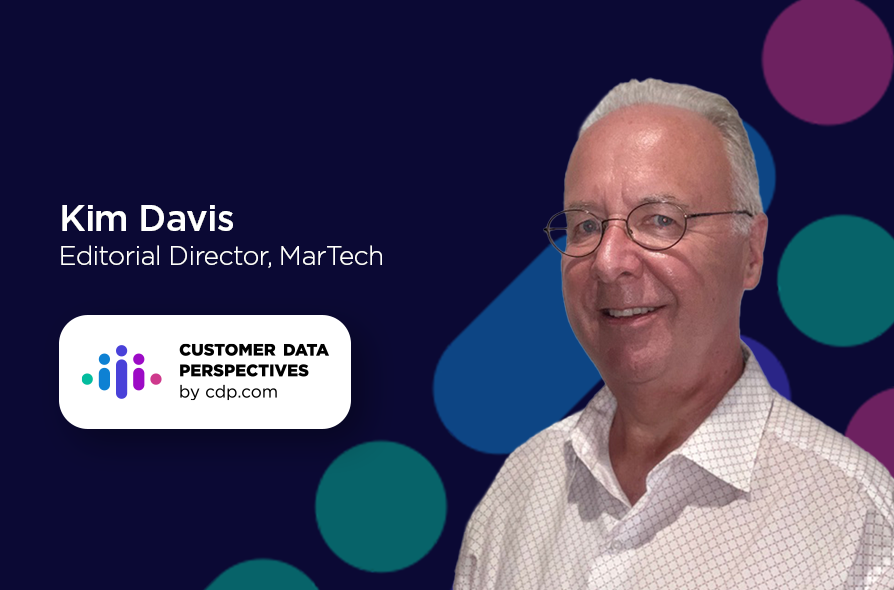Isaac Sacolick, StarCIO recounts his conversation with Kim Davis, editorial director, MarTech, on CDP implementation and overall CDP strategy. Watch or listen to the full conversation below, and check out more Customer Data Perspectives podcasts here.
I am fortunate to meet many people who share their expertise and opinions about technologies and platforms through my writing, speaking, and travels. In the first episode of Customer Data Perspectives, I met David Raab of The CDP Institute, who explained what a customer data platform (CDP) is, and why you need one.
In that episode, we get into the technical details pretty quickly, reviewing the differences between CDPs and other platforms such as customer relationship management (CRM), Data Management Platforms (DMPs), and Master Data Management (MDM). It’s a great listen for everyone who wants to make sense of all the technical buzzwords while learning about the business problems and technical capabilities CDPs address.
In the latest episode of Customer Data Perspectives, I spoke with Kim Davis, Editorial Director at MarTech, and he provided several easy-to-understand lessons about CDPs. It’s a great listen for everyone who wants a 101 course on integrating the data, customer journeys, and marketing attribution. He leaves the best for last with his insights on zero-trust data, and you’ll have to tune into the podcast to hear them!
If you’re new to CDPs, customer 360 initiatives, personalizing messages, managing activations, and integrating customer support functions, here are some of Davis’ insights.
CDPs Centralize Customer Data from Hundreds of Platforms
Davis starts with the basics and says, “The outcome marketers are looking for is what is commonly called a single source of truth. It’s also sometimes called a 360-degree view of the customer.”
It seems so basic that centralizing customer data should have been addressed with all the IT invested over the last two decades. But it’s not because, with every set of new capabilities such as mobile apps, social media platforms, and advertising tools, there are new technologies collecting customer data. In fact, the 2022 version of Chiefmartec’s marketing technology landscape identifies almost 10,000 technologies used by marketing departments, and the average enterprise uses 91 marketing cloud services. So, it’s not easy to centralize, merge, and cleanse this data.
Davis continues why bringing this data is important for digital marketers, “The question each brand has to figure out is where are their customers? What channels are they in? Because the customer will be insistent that you meet them, where they are.”
While this may all sound like B2C challenges common in retail, e-commerce, and entertainment, both B2B and B2C companies from many industries, including financial services, consumer packaged goods, and life sciences, are investing in CDPs. David adds, “Increasingly, the B2B buyer expects a frictionless and largely self-serve digital experience, the same as they get from B2C.”
Implementing a CDP: Define the Goals Before Hitting the Trail
Although CDPs sound simple, they require a customer data platform integration strategy with plans to achieve quick wins and a roadmap to deliver longer-term value. You don’t go on a hike without a trail map, the right gear, and maybe a guide. Business leaders should think about CDP implementations the same way.
Planning a CDP implementation requires answering several upfront questions that Davis simplifies during the podcast. He says, “You have to ask yourself questions like what’s the current state of our data? What do you want to be able to do with the customer data? Have you got the staffing and people who can operate it?”
Here’s how I break this down:
- The current state of the data refers to inventorying data sources, reviewing data quality, and evaluating approaches to unify customer identities.
- How you want to use customer data depends on the department and business objectives, and common marketing activities include developing multiple customer segments, experimenting with activations, analyzing results, and iterating on improvements.
- Having the right staffing implies that you organize a multidisciplinary team of marketers, customer support leaders, technologists, data engineers, and privacy officers ready to collaborate on the implementation.
Davis has this key recommendation and says, “Don’t try and do it all at once and grab all your data from everywhere and push it into the CDP. Be guided by the use cases you’re planning to undertake, which will help prioritize the data to focus on.”
Invest in Realistic and Meaningful Attribution
Once data is loaded, a CDP’s value and impact are driven by how each department uses the data. CDPs are used to nurture leads, manage customer churn, prioritize sales pipelines, and improve customer support processes.
For marketing teams, primary use cases include defining campaigns, customizing segments, testing messages, and creating activation workflows. In other words, they are running ads, sending emails, and posting on social media to tailored segments with dozens to hundreds of messages, aiming to learn which ones garner optimal responses.
Understanding who did what before making a purchase is the attribution model, or as David puts it, “identifying the action taken by the marketing or the sales organization which caused the conversion.”
In many cases, looking for causal relationships through customer journeys is a data science pipe dream. Davis acknowledges that “unfortunately, the world got really complicated over the last five to 10 years. The number of touchpoints on a customer journey is bewildering online, offline apps, web advertisements, social media, peer reviews, and customers are getting information from all those different places.”
That doesn’t mean giving up on attribution, but it does require setting realistic and meaningful objectives. There are first touch, last touch, and multi-touch models, but as I say in the podcast, if my friend shares a product recommendation at the bar and I one-click-buy it online, there’s no way the attribution model’s going to make that correlation.
“The best you can do is have a real-time understanding of what customers are doing at any moment where they are, what touchpoints are affecting them, and be able in real-time to optimize,” says Davis.
That’s a great place to start, but dedicated organizations find clever ways to capture relevant data to improve their attribution models. One of those ways is by creating experiences that capture zero-party data, but you’ll have to tune into the podcast to get Davis’s views on it!



